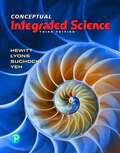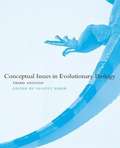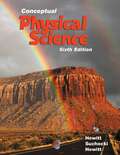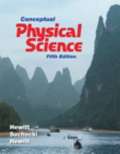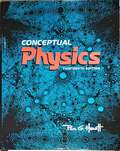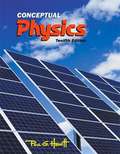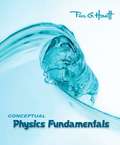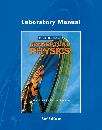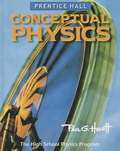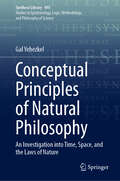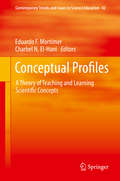- Table View
- List View
Conceptual Integrated Science
by Paul G. Hewitt John A. Suchocki Jennifer Yeh Suzanne A LyonsConceptual Integrated Science connects ideas across the sciences with an engaging overview of physics, chemistry, earth science, astronomy and biology, at a level appropriate for non-science students. Author Paul Hewitt's engaging narrative emphasizes unifying concepts across physical and life sciences in a clear, friendly writing style with fun, relevant examples. The 3rd Edition expands on the theme of integration, deepening connections between the sciences with Integrated Science spreads. Updated Technology boxes feature modern references and contemporary applications that add relevance to help you connect science with your everyday life.
Conceptual Integrated Science
by Paul G. HewittThis book will change the way you look at science. Written by best-selling author Paul Hewitt, Conceptual Integrated Science is more than a collection of facts-it's a guidebook for understanding the world around you. Using his successful "concepts first" method, accessible writing, and fun and informative illustrations, Hewitt and his team of science experts have crafted a text that focuses on unifying concepts and real-life examples across physics, chemistry, earth science, biology, and astronomy. <p><p> The book includes Hewitt's effective teaching method, straight-forward learning features, approachable style, and rigorous coverage. The result is a wide-ranging science text that is uniquely effective and motivational. Conceptual Integrated Science is accompanied by an unparalleled media package that combines Interactive Tutorials, Interactive Figures, and renowned demonstration videos to help you outside of class.
Conceptual Integrated Science Explorations (Florida Edition)
by John Suchocki Paul G. Hewitt Suzanne LyonsScience textbook for Florida students.
Conceptual Integrated Science--explorations
by Paul HewittFrom the author of the number one textbooks in physical science and physics comes the eagerly awaiting new text, Conceptual Integrated Science. Hewitt's critically acclaimed conceptual approach has led science education for 30 years and now tackles integrated science to take student learning to a new level. Using his proven conceptual approach, accessible writing, and fun and informative illustrations, Hewitt and his team of science experts have crafted a text that focuses on the unifying concepts and real-life examples across physics, chemistry, earth science, biology, and astronomy.The book includes best-selling author Paul Hewitt's proven pedagogical approach, straight-forward learning features, approachable style, and rigorous coverage. The result is a wide-ranging science text that is uniquely effective and motivational. Conceptual Integrated Science is accompanied by an unparalleled media package that combines interactive tutorials, interactive figures, and renowned demonstration videos to help students outside of class and instructors in class.
Conceptual Issues in Evolutionary Biology
by Elliott SoberThese essays by leading scientists and philosophers address conceptual issues that arise in the theory and practice of evolutionary biology. The third edition of this widely used anthology has been substantially revised and updated. Four new sections have been added: on women in the evolutionary process, evolutionary psychology, laws in evolutionary theory, and race as social construction or biological reality. Other sections treat fitness, units of selection, adaptationism, reductionism, essentialism, species, phylogenetic inference, cultural evolution, and evolutionary ethics. Each of the twelve sections contains two or three essays that develop different views of the subject at hand. For example, the section on evolutionary psychology offers one essay by two founders of the field and another that questions its main tenets. One sign that a discipline is growing is that there are open questions, with multiple answers still in competition; the essays in this volume demonstrate that evolutionary biology and the philosophy of evolutionary biology are living, growing disciplines. ContributorsRobin O. Andreasen, Kwame Anthony Appiah, David A. Baum, John H. Beatty, David J. Buller, Leda Cosmides, James Donoghue, Steven J. Farris, Joseph Felsenstein, Susan K. Finsen, Joseph Fracchia, Stephen Jay Gould, Sarah Blaffer Hrdy, David L. Hull, Philip Kitcher, R. C. Lewontin, Elisabeth Lloyd, Ernst Mayr, Michael Ruse, John Maynard Smith, Elliott Sober, John Tooby, C. Kenneth Waters, George C. Williams, David Sloan Wilson, E. O. Wilson
Conceptual Physical Science
by John Suchocki Paul G. Hewitt Leslie A. HewittConceptual Physical Science, Second Edition, with its important ancillaries, provides a first introduction to physics, chemistry, earth science, and astronomy, melded in a manner to captivate student interest.
Conceptual Physical Science
by John Suchocki Paul Hewitt Leslie HewittConceptual Physical Science, Sixth Edition, provides a conceptual overview of basic, essential topics in physics, chemistry, earth science, and astronomy with optional quantitative analyses. The authors focus on concepts before computations. With its clear, friendly writing style, and strong integration of the sciences, this book connects well with all students.
Conceptual Physical Science (Fifth Edition)
by Paul G. Hewitt Leslie A. Hewitt John A. SuchockiConceptual Physical Science, Fifth Edition, takes learning physical science to a new level by combining Hewitt's leading conceptual approach with a friendly writing style, strong integration of the sciences, more quantitative coverage, and a wealth of media resources to help professors in class, and students out of class. It provides a conceptual overview of basic, essential topics in physics, chemistry, earth science, and astronomy with optional quantitative coverage.
Conceptual Physical Science: Explorations
by John Suchocki Paul G. Hewitt Leslie A. HewittPhysics textbook for high school and college.
Conceptual Physical Science: Explorations
by John Suchocki Paul G. Hewitt Leslie A. HewittTextbook on physical science.
Conceptual Physical Science: Explorations (2nd Edition)
by Paul G. Hewitt Leslie A. Hewitt John A. SuchockiConceptual Physical Science: Explorations introduces physical science to students using a conceptual approach. It melds physics, chemistry, Earth science, and astronomy, in a manner that captivates student interest. This second edition of CPSE is a major upgrade from the first edition. In addition to a smoother flow of topics and updates to scientific advances (especially in astronomy) numerous new and exciting features are designed to help students learn most efficiently.
Conceptual Physics
by Paul G. HewittConceptual Physics, Tenth Edition helps readers connect physics to their everyday experiences and the world around them with additional help on solving more mathematical problems. Hewitt's text is famous for engaging readers with analogies and imagery from real-world situations that build a strong conceptual understanding of physical principles ranging from classical mechanics to modern physics. With this strong foundation, readers are better equipped to understand the equations and formulas of physics, and motivated to explore the thought-provoking exercises and fun projects in each chapter. Included in the package is the workbook. Mechanics, Properties of Matter, Heat, Sound, Electricity and Magnetism, Light, Atomic and Nuclear Physics, Relativity. For all readers interested in conceptual physics.
Conceptual Physics
by Paul G. HewittConceptual Physics 13e with Modified Mastering Physics with Pearson eText
Conceptual Physics (12th Edition)
by Paul G. HewittConceptual Physics with MasteringPhysics® , Twelfth Edition Paul Hewitt integrates a compelling text and the most advanced media to make physics interesting, understandable, and relevant for non-science majors. The Twelfth Edition will delight you with informative and fun Hewitt-Drew-It screencasts, updated content, applications, and new learning activities in MasteringPhysics.<p><p> Hewitt’s text is guided by the principle of "concepts before calculations" is famous for engaging students with analogies and imagery from the real-world that build a strong conceptual understanding of physical principles ranging from classical mechanics to modern physics.<p> This program presents a better teaching and learning experience–for you.<br> - Personalize learning with MasteringPhysics: MasteringPhysics provides you with engaging experiences that coach you through physics with specific wrong-answer feedback, hints, and a huge variety of educationally effective content.<br> - Prepare for lecture: NEW! 100 Hewitt-Drew-It screencasts, authored and narrated by Paul Hewitt, explain physics concepts through animation and narration. The exciting new Screencasts, accessed through QR codes in the textbook, will enable you to engage with the physics concepts more actively outside of class.<br> - Make physics delightful: Relevant and accessible narrative, analogies from real-world situations, and simple representations of the underlying mathematical relationships make physics more appealing.<br> - Build a strong conceptual understanding of physics: You will gain a solid understanding of physics through practice and problem solving in the book and in MasteringPhysics.
Conceptual Physics Fundamentals
by Paul G. Hewitt Phillip R. WolfFrom Paul G. Hewitt, author of the market-leading Conceptual Physics, comes his eagerly awaited new, briefer, alternative text, Conceptual Physics Fundamentals. The text extends best-selling author Paul Hewitt's proven pedagogical approach, straight-forward learning features, approachable style, and rigorous coverage, while providing superior supplements and media. The book develops a solid conceptual understanding of physics, while building readers' self-confidence applying their understanding quantitatively. About Science, Equilibrium and Linear Motion, Newton's Laws of Motion, Momentum and Energy, Gravity, Projectiles, and Satellites, Fluid Mechanics, Temperature, Heat, and Thermodynamics, Heat Transfer and Change of Phase, Electrostatics and Electric Current, Magnetism and Electromagnetic Induction, Waves and Sound, Light waves, Properties of Light, Atoms, Quantum Theory, The Atomic Nucleus and Radioactivity. For all readers interested in conceptual physics.
Conceptual Physics, 1999/2002
by Paul G. HewittThe author treats physics conceptually in this book, which means concepts are presented in familiar English, with equations as "guides to thinking." Comprehension of concepts before calculation is the key to understanding. Enjoy your physics!
Conceptual Physics: Laboratory Manual
by Paul RobinsonThis lab manual contains 61 activities and 38 experiments. Most activities are designed to provide you with hands-on experience that relates to a specific concept. Experiments are usually designed to give you practice using a particular piece of apparatus.
Conceptual Physics: The High School Physics Program
by Paul G. HewittThis seventh edition of the popular and exceptionally well written physics concept text with minimal mathematics contains new material sprinkled throughout, such as a treatment of measurements of the earth, moon, and sun by the early Greeks, capacitors, and more on rainbows. Individual sections have been clarified and updated. Problem sets are now at the end of most chapters. Most problems involve simple calculations that require minimal algebra skills. The text is profusely illustrated in full color with many helpful diagrams and down-to-earth examples. Annotation c. by Book News, Inc., Portland, Or.
Conceptual Physics: The High School Physics Program
by Paul G. HewittThis book guides the reader to see physics as the rules of the physical world, and to teach how the equations of physics reveal the connections in nature, focusing on the physics concepts themselves, their similarities, and their differences. This book contains analogies and clear explanations, more qualitative questions than algebraic problems to discover physics as fascinating, to provide a solid science foundation, and to see that knowledge of physics is important to overall education.
Conceptual Physics: The High School Physics Program
by Paul G. HewittThis seventh edition of the popular and exceptionally well written physics concept text with minimal mathematics contains new material sprinkled throughout, such as a treatment of measurements of the earth, moon, and sun by the early Greeks, capacitors, and more on rainbows. Individual sections have been clarified and updated. Problem sets are now at the end of most chapters. Most problems involve simple calculations that require minimal algebra skills. The text is profusely illustrated in full color with many helpful diagrams and down-to-earth examples. Annotation C. by Book News, Inc., Portland, Or.
Conceptual Physics: The High School Physics Program (3rd edition)
by Paul G. HewittPhysics textbook for high school students.
Conceptual Physics: The High School Physics Program with Expanded Technology (3rd edition)
by Paul G. HewittPhysics textbook for high school students
Conceptual Principles of Natural Philosophy: An Investigation into Time, Space, and the Laws of Nature (Synthese Library #495)
by Gal YehezkelThis book provides a general framework for understanding nature to revive the philosophical study of nature as a complementary research project to the empirical exploration of nature. It demonstrates that the a priori research of nature is a viable science, by articulating its principles and demonstrating their effectiveness in explaining the most fundamental features of nature – time, space, and its laws. The original contribution of this book is twofold. Firstly, it introduces a unique method for undertaking conceptual analysis. The effectiveness of these tools is demonstrated in exploring the most general and fundamental features of nature. Secondly, it introduces a novel conception of nature – "internal relationalism" – that offers an insight into the structure of nature and its most fundamental features. Thus, it offers answers to some of the most fundamental questions that have plagued philosophers and scientists for millennia, concluding with the question “Why is there something rather than nothing?” This book is of interest to metaphysics, philosophers of science who focus on the foundations of physics, and philosophically-minded physicists, especially those whose research interests include the nature of time and space.
Conceptual Profiles: A Theory of Teaching and Learning Scientific Concepts (Contemporary Trends and Issues in Science Education #42)
by Eduardo F. Mortimer Charbel N. El-HaniThe language of science has many words and phrases whose meaning either changes in differing contexts or alters to reflect developments in a given discipline. This book presents the authors' theories on using 'conceptual profiles' to make the teaching of context-dependent meanings more effective. Developed over two decades, their theory begins with a recognition of the coexistence in the students' discourse of those alternative meanings, even in the case of scientific concepts such as molecule, where the dissonance between the classical and modern views of the same phenomenon is an accepted norm. What began as an alternative model of conceptual change has evolved to incorporate a sociocultural approach, by drawing on ideas such as situated cognition and Vygotsky's influential concept of culturally located learning. Also informed by pragmatist philosophy, the approach has grown into a well-rounded theory of teaching and learning scientific concepts. The authors have taken the opportunity in this book to develop their ideas further, anticipate and respond to criticisms--that of relativism, for example--and explain how their theory can be applied to analyze the teaching of core concepts in science such as heat and temperature, life and biological adaptation. They also report on the implementation of a research program that correlates the responsiveness of their methodology to all the main developments in the field of science education. This additional material will inform academic discussion, review, and further enhancement of their theory and research model.
